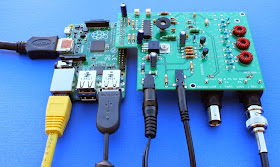I'll have to improve my skills a bit but it's a great way to combine two hobbies.
Monday, January 26, 2015
Raising antennas with a drone
Stephen, VK2BLQ, has suggested we try holding an HF vertical up with a drone but here's another idea for antenna installation in tall trees.
I'll have to improve my skills a bit but it's a great way to combine two hobbies.
I'll have to improve my skills a bit but it's a great way to combine two hobbies.
Good value laptop for ham radio use - Lenovo X201
Recently there have been a constant stream of second hand Lenovo X201 laptops on ebay here. David Rowe mentioned when he visited that the X200 series is the last "good" Lenovo laptops from a technical Linux using perspective. Here's the one I picked up for $240 but they range from $200-$300.
I like these for the following reasons:
I like these for the following reasons:
- Solid build
- Easy access to the hard drive - one screw and it pops out of the side.
- Old style boot, not UEFI, so you can install old Windows
- Fairly compact
- Tolerant of high RF (My old MSI netbook goes a bit crazy when transmitting)
- Decent CPU - i5 with quad core can keep up with DSP tasks
Mine came with a pretty dead battery so I paid another $40 to get a new 9 cell replacement. I had a 240GB SSD handy so I used a USB key with a gparted live linux system on it to dd copy the internal disk over to an external drive case and then swapped the drive. (These little bootable USB utilities are a very useful tool in the kit).
As you can see above, I'm dual booting Ubuntu for WSPR but also keeping Windows 7 around for the Windows only software I sometimes need to run.
Sunday, January 11, 2015
Skypi 40m transmitter controlled by Raspberry Pi
Just saw this interesting gadget called a Skypi from RadWAV.
It appears to be a 1W carrier transmitter for 40m that plugs in to the GPIO socket on a Raspberry Pi. The board requires 12V and it produces 5V to power the Raspberry Pi board via the connector.
They've modified existing software to control the frequency and carrier so that it can transmit WSPR, RTTY and CW. For CW they can read a key plugged in to the board.
Note that this is not a transceiver, which is a pity. They offer an optional output socket for a receiver and the board switches the antenna to that port between transmissions - there's demonstration audio of how it sounds.
It's great that RadWAV has created this product but I'd really like to see at least a block diagram of it. The documentation is sent to you by email after ordering.
Personally, I'm hanging out for the OpenRadio SDR which is being launched at Linux Conf AU which starts on Monday 12th Jan.
The SkyPi kit is US$85 or US$185 assembled including the receiver output port.
It appears to be a 1W carrier transmitter for 40m that plugs in to the GPIO socket on a Raspberry Pi. The board requires 12V and it produces 5V to power the Raspberry Pi board via the connector.
They've modified existing software to control the frequency and carrier so that it can transmit WSPR, RTTY and CW. For CW they can read a key plugged in to the board.
Note that this is not a transceiver, which is a pity. They offer an optional output socket for a receiver and the board switches the antenna to that port between transmissions - there's demonstration audio of how it sounds.
It's great that RadWAV has created this product but I'd really like to see at least a block diagram of it. The documentation is sent to you by email after ordering.
Personally, I'm hanging out for the OpenRadio SDR which is being launched at Linux Conf AU which starts on Monday 12th Jan.
The SkyPi kit is US$85 or US$185 assembled including the receiver output port.

